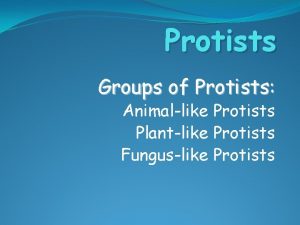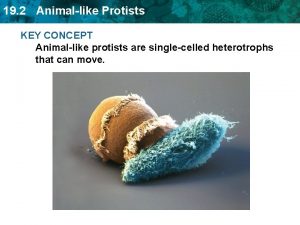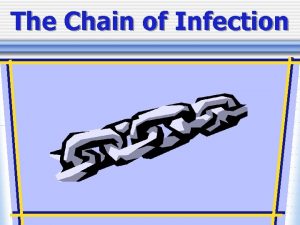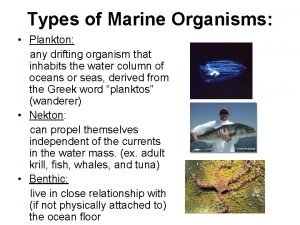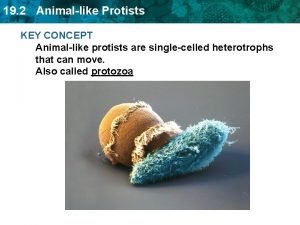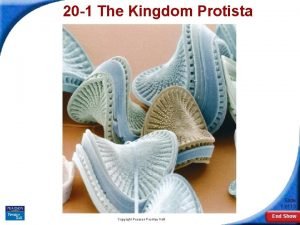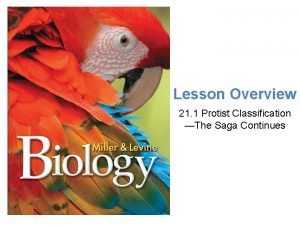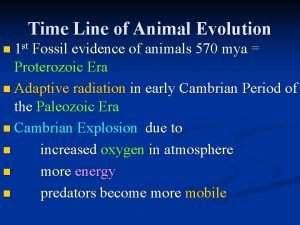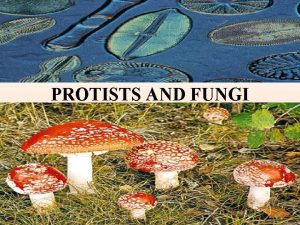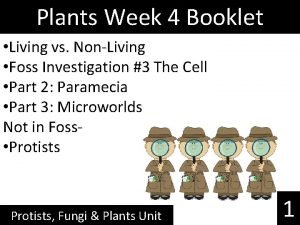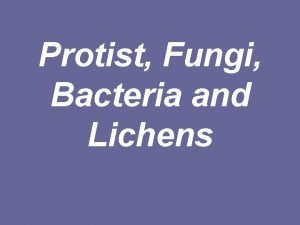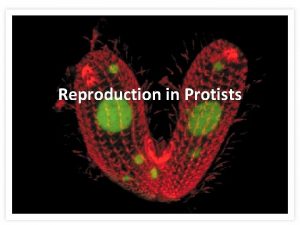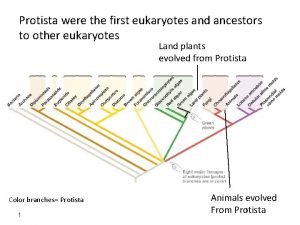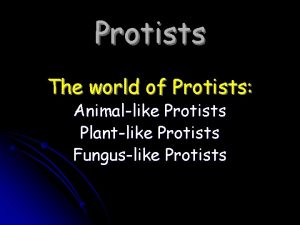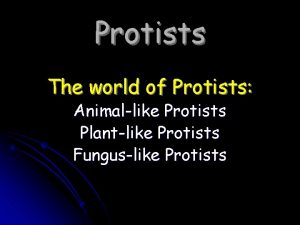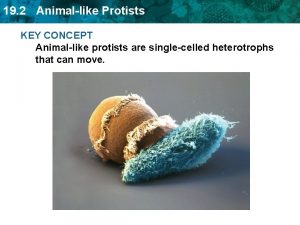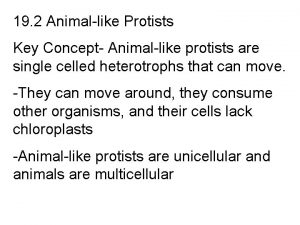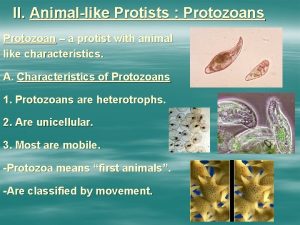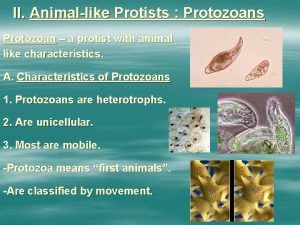19 1 PROTISTS ANIMALLIKE PLANTLIKE FUNGILIKE GENERAL PROTIST
















- Slides: 16

19 -1 PROTISTS ANIMAL-LIKE PLANT-LIKE FUNGI-LIKE

GENERAL PROTIST TRAITS • Unicellular; most are photosynthetic • Eukaryotic • Oldest fossils of protists are 1. 5 billion yrs old. Produce much of oxygen in atmosphere. Branched off from the Archeabacteria • Hard to classify due to combinations of traits • Many feel they are a result of prokaryotic cells joining together in symbiotic relationships – The Endosymbiont Hypothesis

ANIMAL-LIKE PROTISTS • Ciliophora – move with hair-like structures on surface of cell called cilia Ex. paramecium Loxodes Courtesy David Patterson Pg. 548 reproduction

ANIMAL-LIKE PROTISTS CON’T • Sarcodina- move by pushing out extensions of the cytoplasm called pseudopods. • Example- amoeba Reproduce asexually

ANIMAL-LIKE-PROTISTS CONT • Sporozoa – Do not move at all. parasitic and cause disease. Are • Example- Plasmodium (malaria) PHYLUM SPOROZOA pg 551 for cycle of reproduction

§ The life cycle of sporozoans has both sexual and asexual stages. Malaria Life Cycle pg 551

ANIMAL-LIKE PROTISTS • Zoomastigina – Move by long whip-like structures called flagellum • Example: trypanosoma (sleeping sickness) • Spread by Tsetse fly or the reduviid bug to humans PHYLUM ZOOMASTIGINA Not all are parasites

PLANT-LIKE PROTISTS • Diatoms (Chrysophyta)– Made with a box-like silica shell with cytoplasm inside. Skeletons of this group are used as abrasives in toothpaste. Example – (PG 555) Photosynthetic autotrophs

PLANT-LIKE PROTISTS • Pyrrophyta- also known as the dinoflagellates are bioluminescent (emit light) • Cause algal blooms and red tides which can be harmful because they delete nutrients in the water. Some produce toxins harmful to man.

PLANT-LIKE PROTISTS • Euglenoids- Have flagella but are photosynthetic. Example- Euglena can be autotrophic or heterotroph Pg. 556 • E

PLANT-LIKE PROTISTS - ALGAE • Brown (Phaeophyta) pigment fucoxanthin (kelp) • Green (Chlorophyta) pigment chlorophyll (desmids, spirogyra. volvox) • Red (Rhodophyta) pigment phycobilins (coralline) • Algal uses on page 559

Phaeophyta Rhodophyta Chlorophyta

FUNGUS-LIKE PROTISTS • Slime Molds – Very unusual, single celled amoeboid cells which can join together to function as a multi-cellular organism. UNIQUE!! Pg 562 -3

Cellular Slime Molds – Life Cycle § Cellular slime molds are found in the phylum Acrasiomycota. § Reproduce both sexually and asexually. § Pg 563 Diagram § Acellular slime molds are found in the phylum Myxomycota. Pg 562 (diagram)

FUNGUS-LIKE PROTISTS • • Water molds and Downy Mildews Oomycota live in water or damp places Envelope food sources with mass of threads that break down tissues Irish potato blight in 1800’s which killed 1, 000 people due to starvation (Phytophythora infestans)

Water Mold Downy Mildew
 Sporazoans
Sporazoans Animal-like protist
Animal-like protist Chapter 15:2 bioterrorism
Chapter 15:2 bioterrorism Plantlike organisms that live on dead organic matter
Plantlike organisms that live on dead organic matter Is phytoplankton a protist
Is phytoplankton a protist Animal protists
Animal protists Protist evolution
Protist evolution Sporozoa
Sporozoa Opisthokonta definition
Opisthokonta definition Protist cladogram
Protist cladogram Protist evolution
Protist evolution Asexual reproduction in fungi
Asexual reproduction in fungi Euglena living or nonliving
Euglena living or nonliving Celula
Celula Reproduction of protista
Reproduction of protista The first eukaryotes were
The first eukaryotes were Protist
Protist
